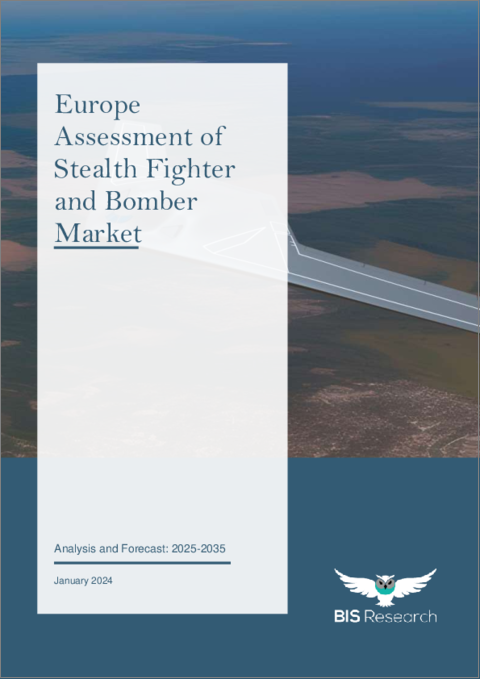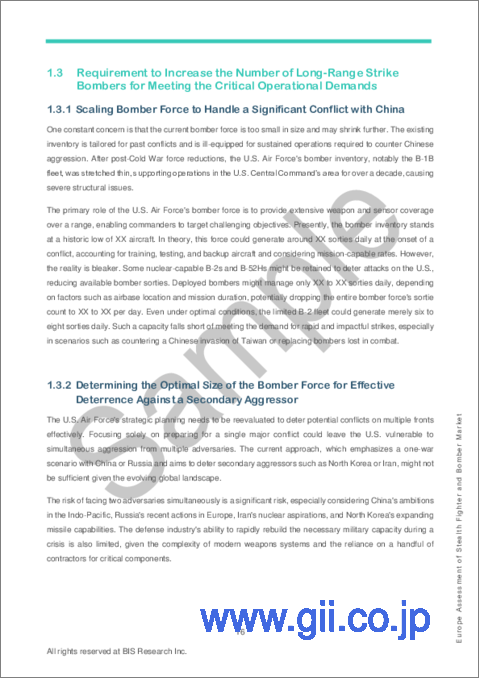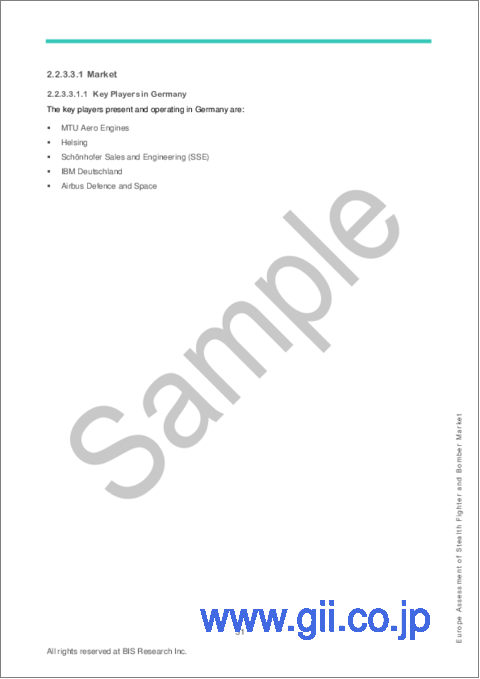|
|
市場調査レポート
商品コード
1403555
欧州のステルス戦闘機および爆撃機市場:分析と予測(2025年~2035年)Europe Assessment of Stealth Fighter and Bomber Market: Analysis and Forecast, 2025-2035 |
||||||
カスタマイズ可能
|
|||||||
| 欧州のステルス戦闘機および爆撃機市場:分析と予測(2025年~2035年) |
|
出版日: 2024年01月08日
発行: BIS Research
ページ情報: 英文 82 Pages
納期: 1~5営業日
|
全表示
- 概要
- 図表
- 目次
欧州のステルス戦闘機および爆撃機の市場規模は、2025年の2億2,500万米ドルから2035年には7億1,400万米ドルに成長し、予測期間の2025年~2035年のCAGRは12.24%になるとみられています。
ステルス技術は、刻々と変化する防衛情勢において、国境を確保し、世界の空域における優位性を維持するために不可欠な要素です。ステルス爆撃機はマルチロールであることを意図しており、様々な任務を遂行することができます。次世代ステルス爆撃機は、戦略核抑止や長距離攻撃任務から電子戦や情報収集に至るまで、新たな脅威や作戦目的に適応できる資産です。さらに、B-21レイダーのようなステルス爆撃機は、地上部隊との交戦、偵察飛行、秘密情報任務の遂行、敵レーダーシステムの撹乱などの能力により、現代の空軍において重要な役割を果たしています。発見される危険を最小限に抑えながら敵の空域でこれらの作戦を実行するそのユニークな能力は、その戦略的重要性を強調しています。
| 主要市場統計 | |
|---|---|
| 予測期間 | 2025年~2035年 |
| 2025年評価 | 2億2,500万米ドル |
| 2035年予測 | 7億1,400万米ドル |
| CAGR | 12.24% |
同市場は、先進的なステルス爆撃機や戦闘機の開発と配備に重点を置いており、軍事航空技術の進歩を示しています。世界各国が最先端の防衛能力に投資する中、最も洗練されたステルス爆撃機の開発競争が過熱しています。技術面では、レーダーを凌駕する素材や設計、性能向上のための推力ベクトル化などの市場開拓が大きく進展しています。
当レポートでは、欧州のステルス戦闘機および爆撃機市場について調査し、市場の概要とともに、用途別、国別の動向、および市場に参入する企業のプロファイルなどを提供しています。
目次
エグゼクティブサマリー
調査範囲
第1章 市場
- 業界の見通し
- 次世代ステルス爆撃機:概要
- 長距離攻撃爆撃機の使用例
- 重要な作戦上の需要を満たすために長距離攻撃爆撃機の数を増やす必要性
- 進行中のプログラム
- 現在および新たな技術動向
- サプライチェーン分析
- ビジネスダイナミクス
第2章 欧州
- ステルス戦闘機および爆撃機市場の評価(地域別)
- 欧州
- 市場
- 応用
- 欧州(国別)
第3章 市場- 主要な参入企業
- 主な参入企業
第4章 調査手法
List of Figures
- Figure 1: Assessment of Stealth Fighter and Bomber Market, $Billion, 2025-2035
- Figure 2: Assessment of Stealth Fighter and Bomber Market, Units, 2025-2035
- Figure 3: Assessment of Stealth Fighter and Bomber Market (by Application), $Billion, 2025 and 2035
- Figure 4: Assessment of Stealth Fighter and Bomber Market (by Application), Units, 2025 and 2035
- Figure 5: Assessment of Stealth Fighter and Bomber Market (by Region), $Billion, 2035
- Figure 6: Supply Chain Analysis for Assessment of Stealth Fighter and Bomber Market
- Figure 7: Assessment of Stealth Fighter and Bomber Market, Business Dynamics
- Figure 8: Research Methodology
- Figure 9: Top-Down and Bottom-Up Approach
- Figure 10: Assumptions and Limitations
List of Tables
- Table 1: Assessment of Stealth Fighter and Bomber Market (by Region), $Billion, 2025-2035
- Table 2: Assessment of Stealth Fighter and Bomber Market (by Region), Units, 2025-2035
- Table 3: Europe Assessment of Stealth Fighter and Bomber Market (by Application), Units, 2025-2035
- Table 4: Europe Assessment of Stealth Fighter and Bomber Market (by Application), $Million, 2025-2035
- Table 5: Russia Assessment of Stealth Fighter and Bomber Market (by Application), Units, 2025-2035
- Table 6: Russia Assessment of Stealth Fighter and Bomber Market (by Application), $Million, 2025-2035
- Table 7: Key Participants
“The Europe Assessment of Stealth Fighter and Bomber Market Expected to Reach $714.0 Million by 2035.”
Introduction to Europe Assessment of Stealth Fighter and Bomber Market
The Europe assessment of stealth fighter and bomber market will grow from $225.0 million in 2025 to $714.0 million by 2035, at a CAGR of 12.24% during the forecast period 2025-2035. Stealth technology is a critical element for securing national boundaries and maintaining dominance in global airspace in an ever-changing defensive landscape. Stealth bombers are meant to be multirole, allowing them to conduct a variety of missions. Next-generation stealth bomber aircraft are adaptable assets that can adapt to new threats and operational objectives, from strategic nuclear deterrent and long-range attack missions to electronic warfare and information collection. Furthermore, stealth bombers like the B-21 Raider play an important role in modern air forces due to their ability to engage ground units, undertake reconnaissance flights, execute clandestine intelligence missions, and disrupt enemy radar systems. Their unique capacity to perform these operations in enemy airspace while minimizing the danger of detection emphasizes their strategic significance.
| KEY MARKET STATISTICS | |
|---|---|
| Forecast Period | 2025 - 2035 |
| 2025 Evaluation | $225.0 Million |
| 2035 Forecast | $714.0 Million |
| CAGR | 12.24% |
Market Introduction
The analysis of the stealth fighter and bomber market encompasses a full examination of the industry, which includes established titans such as Lockheed Martin and Northrop Grumman, as well as rising start-ups attempting to make their mark in this technologically advanced field. This market is focused on the development and deployment of advanced stealth bomber and fighter aircraft, demonstrating the advancement of military aviation technology. As countries around the world invest in cutting-edge defense capabilities, the race to develop the most sophisticated and stealthy bombers has heated up. This market highlights the key competitors, technological breakthroughs, market trends, and strategic efforts that are shaping the evaluation of the stealth fighter and bomber market landscape. In terms of technology, the market is seeing major developments in radar-evading materials and designs, as well as thrust vectoring for improved performance.
Market Segmentation:
Segmentation 1: by Application
- Intelligence, Surveillance, and Reconnaissance (ISR)
- Electronic Warfare (EW)
- Precision Strike
The assessment of stealth fighter and bomber market is expected to generate huge revenues for electronic warfare (EW) and precision strikes.
Segmentation 2: by Country
- U.K.
- Germany
- Italy
- Russia
- Turkiye
- France
How can this report add value to an organization?
Product/Innovation Strategy: The study provides the reader with a detailed understanding of the assessment of stealth fighter and bomber market by application on the basis of application (intelligence, surveillance, and reconnaissance (ISR), electronic warfare (EW) and precision strike).
Growth/Marketing Strategy: The Europe assessment of stealth fighter and bomber market has seen major development by key players operating in the market, such as business expansion, partnership, collaboration, and joint venture. The favored strategy for the companies has been merger and acquisition to strengthen their position in the assessment of stealth fighter and bomber market. For instance, in January 2023, Germany made a substantial financial commitment to the FCAS program, allocating approximately $43 billion. This funding underscores the nation's dedication to the development of a sixth-generation platform that would redefine air dominance. The next-generation fighter (NGF) is poised to be the centerpiece of FCAS, equipped with a new engine, advanced armament systems, cutting-edge stealth technology, enhanced sensors, and the capability to communicate seamlessly with unmanned aircraft. Moreover, it will be a vital component of the air-combat cloud network.
Methodology: The research methodology design adopted for this specific study includes a mix of data collected from primary and secondary data sources. Both primary resources (key players, market leaders, and in-house experts) and secondary research (a host of paid and unpaid databases), along with analytical tools, are employed to build the predictive and forecast models.
Table of Contents
Executive Summary
Scope of the Study
1. Market
- 1.1. Industry Outlook
- 1.1.1. Next-Generation Stealth Bomber Aircraft: Overview
- 1.2. Use Cases for Long-Range Strike Bombers
- 1.2.1. Unparalleled Options Offered by Long-Range Strike Bombers
- 1.2.2. Advantages of the B-21 as Lead Component of a Long-Range Strike Bomber
- 1.3. Requirement to Increase the Number of Long-Range Strike Bombers for Meeting the Critical Operational Demands
- 1.3.1. Scaling Bomber Force to Handle a Significant Conflict with China
- 1.3.2. Determining the Optimal Size of the Bomber Force for Effective Deterrence Against a Secondary Aggressor
- 1.3.3. Determining the Appropriate Scale for Nuclear Deterrence
- 1.4. Ongoing Programs
- 1.4.1. Future Combat Air System (FCAS)
- 1.4.2. Next-Generation Air Dominance (NGAD)
- 1.4.3. F-X Program
- 1.4.4. Global Combat Air Program (GCAP)
- 1.4.5. TF-X Kaan Fifth-Generation Fighter Jet Program
- 1.5. Current and Emerging Technological Trends
- 1.5.1. Use of Advance Material in Next-Generation Stealth Bombers
- 1.5.2. Advancement in Components
- 1.5.3. Use of Artificial Intelligence (AI) in Stealth Technology
- 1.6. Supply Chain Analysis
- 1.7. Business Dynamics
- 1.7.1. Business Drivers
- 1.7.1.1. Need for Increased Range and Mission Persistence
- 1.7.1.1.1. Need for Increased Capacity to Engage Moving Targets at Scale
- 1.7.1.1. Need for Increased Range and Mission Persistence
- 1.7.2. Business Challenges
- 1.7.2.1. Cost Effectiveness of Next-Generation Stealth Bombers
- 1.7.2.2. Complex Maintenance Requirements
- 1.7.3. Business Opportunities
- 1.7.3.1. Meeting Joint All-Domain Command and Control (JADC2) Requirements
- 1.7.1. Business Drivers
2. Europe
- 2.1. Assessment of Stealth Fighter and Bomber Market (by Region)
- 2.2. Europe
- 2.2.1. Market
- 2.2.1.1. Key Manufacturers and Suppliers in Europe
- 2.2.1.2. Business Drivers
- 2.2.1.3. Business Challenges
- 2.2.2. Application
- 2.2.2.1. Europe Assessment of Stealth Fighter and Bomber Market (by Application), Volume and Value Data
- 2.2.3. Europe (by Country)
- 2.2.3.1. Russia
- 2.2.3.1.1. Market
- 2.2.3.1.1.1. Key Players in Russia
- 2.2.3.1.2. Application
- 2.2.3.1.2.1. Russia Assessment of Stealth Fighter and Bomber Market (by Application), Volume and Value Data
- 2.2.3.1.1. Market
- 2.2.3.2. U.K.
- 2.2.3.2.1. Market
- 2.2.3.2.1.1. Key Players in the U.K.
- 2.2.3.2.1. Market
- 2.2.3.3. Germany
- 2.2.3.3.1. Market
- 2.2.3.3.1.1. Key Players in Germany
- 2.2.3.3.1. Market
- 2.2.3.4. France
- 2.2.3.4.1. Market
- 2.2.3.4.1.1. Key Players in France
- 2.2.3.4.1. Market
- 2.2.3.5. Italy
- 2.2.3.5.1. Market
- 2.2.3.5.1.1. Key Player in Italy
- 2.2.3.5.1. Market
- 2.2.3.6. Turkiye
- 2.2.3.6.1. Market
- 2.2.3.6.1.1. Key Players in Turkiye
- 2.2.3.6.1. Market
- 2.2.3.1. Russia
- 2.2.1. Market
3. Market - Key Company Participants
- 3.1. Key Participants
4. Research Methodology
- 4.1. Factors for Data Prediction and Modeling





